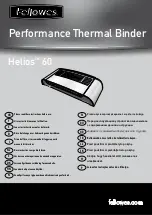
03
.1
3 EN
10
5.2
Operation
5.2.1 Commissioning
Checks and operations to be performed before starting daily work
Procedure
• Make sure the battery is in physically good condition.
• Make sure the terminals are correct (positive to positive and negative to negative)
and check that contacts on the battery terminal conducting system are secure.
• Check the terminal screw torques (M10 = 23 ±1 Nm) of the terminal conductors and
connectors.
• Re-charge the battery.
• Charge the battery.
Check completed.
5.2.2 Discharging the battery
Z
To achieve an optimum useful life avoid operational discharges of more than 60%
of nominal capacity.
Z
If the battery is discharged during operation by more than 80% of rated capacity the
useful life of the battery will reduce significantly. Fully or partially discharged
batteries must be re-charged immediately and not left unattended.
5.2.3 Charging the battery
WARNING!
The gases produced during charging can cause explosions
The battery gives off a mixture of oxygen and hydrogen (electrolytic gas) during
charging. Gassing is a chemical process. This gas mixture is highly explosive and
must not be ignited.
Always disconnect the charger and truck before connecting or disconnecting the
charger and battery.
The charger must be adapted to the battery in terms of voltage, charge capacity
and battery technology.
Before charging, check all cables and plug connections for visible signs of damage.
Ventilate the room in which the truck is being charged.
Battery cell surfaces must remain exposed during charging in order to ensure
sufficient ventilation, see truck operating instructions, chapter D, Charging the
Battery.
Do not smoke and avoid naked flames when handling batteries.
Wherever an industrial truck is parked for charging there must be no inflammable
material or consumables capable of creating sparks within a minimum distance of
2 m from the truck.
Fire protection equipment must be available.
Do not place any metallic objects on the battery.
Always follow the safety regulations of the battery and charger station
manufacturers.
03
.1
3 EN
10
5.2
Operation
5.2.1 Commissioning
Checks and operations to be performed before starting daily work
Procedure
• Make sure the battery is in physically good condition.
• Make sure the terminals are correct (positive to positive and negative to negative)
and check that contacts on the battery terminal conducting system are secure.
• Check the terminal screw torques (M10 = 23 ±1 Nm) of the terminal conductors and
connectors.
• Re-charge the battery.
• Charge the battery.
Check completed.
5.2.2 Discharging the battery
Z
To achieve an optimum useful life avoid operational discharges of more than 60%
of nominal capacity.
Z
If the battery is discharged during operation by more than 80% of rated capacity the
useful life of the battery will reduce significantly. Fully or partially discharged
batteries must be re-charged immediately and not left unattended.
5.2.3 Charging the battery
WARNING!
The gases produced during charging can cause explosions
The battery gives off a mixture of oxygen and hydrogen (electrolytic gas) during
charging. Gassing is a chemical process. This gas mixture is highly explosive and
must not be ignited.
Always disconnect the charger and truck before connecting or disconnecting the
charger and battery.
The charger must be adapted to the battery in terms of voltage, charge capacity
and battery technology.
Before charging, check all cables and plug connections for visible signs of damage.
Ventilate the room in which the truck is being charged.
Battery cell surfaces must remain exposed during charging in order to ensure
sufficient ventilation, see truck operating instructions, chapter D, Charging the
Battery.
Do not smoke and avoid naked flames when handling batteries.
Wherever an industrial truck is parked for charging there must be no inflammable
material or consumables capable of creating sparks within a minimum distance of
2 m from the truck.
Fire protection equipment must be available.
Do not place any metallic objects on the battery.
Always follow the safety regulations of the battery and charger station
manufacturers.
Содержание EZS 350 XL
Страница 1: ...08 09 11 14 51133023 EZS 350 350 XL C40 Operating instructions G EZS 350 XL EZS C40 EZS 350 ...
Страница 3: ...11 14 EN 4 ...
Страница 9: ...0506 GB 2 ...
Страница 14: ...13 11 14 EN 8 o Reverse pedestrian operation button o Rear view mirror t Standard version o Option ...
Страница 18: ...17 11 14 EN 3 2 Dimensions ...
Страница 25: ...11 14 EN 24 ...
Страница 29: ...11 14 EN 28 ...
Страница 39: ...11 14 EN 38 ...
Страница 42: ...41 11 14 EN 2 Displays and Controls 44 4 3 45 41 8 9 7 6 10 41 8 11 43 5 10 42 ...
Страница 77: ...11 14 EN 76 ...













































